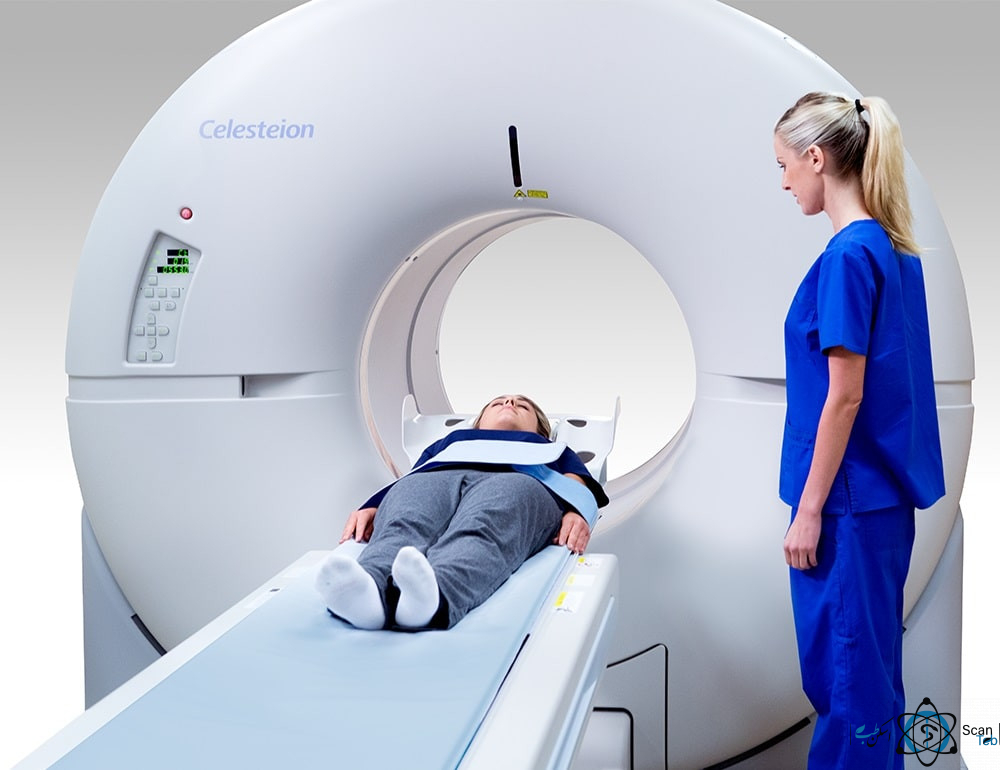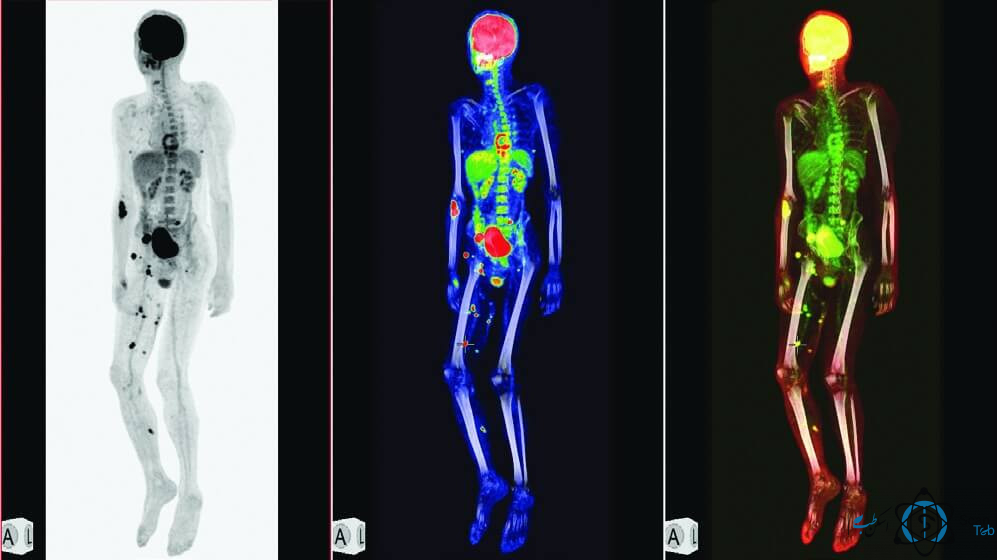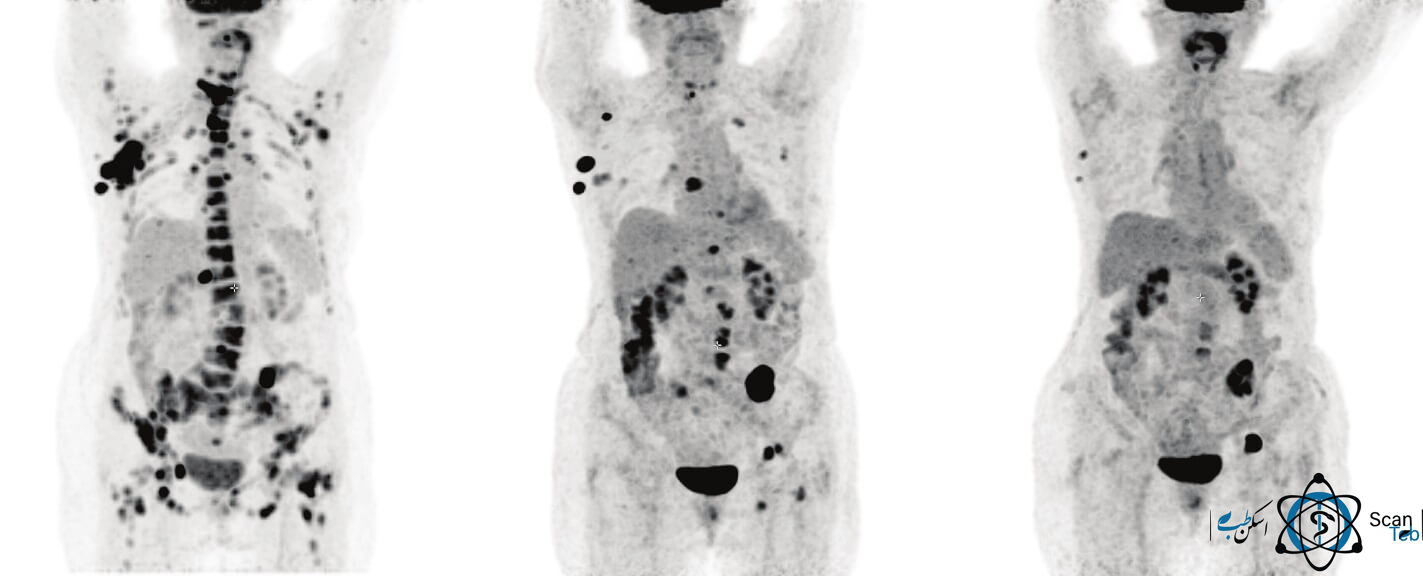همه چیز در مورد پت اسکن
پت اسکن یا PET Scan یکی از تکنیکهای تصویر برداری پزشکی هسته ایست که تصویری سه بعدی از عملکرد ارگانهای بدن بدست میدهد. این سیستم، یک جفت اشعهی گاما را که توسط یک رادیو نوکلئید پوزیترون ده (tracer) تولید شده و در خلاف جهت هم گسیل شده اند آشکار میسازد.
این رادیو نوکلئید توسط یک مولکول بیولوژیکی فعال وارد بدن می شود. سپس، تصویر سه بعدی تجمع دارو درون بدن توسط آنالیز کامپیوتری بازسازی میشود. در اسکنرهای جدید، معمولا یک اسکن CT هم همزمان در همان دستگاه گرفته میشود تا تصویر سه بعدی بدست آمده دقیقتر باشد.

دستگاه PET(Positron Emission Tomography) یكی از سیستمهای پیشرفته تصویربرداری میباشد كه توانمندیهای بینظیری در تشخیص بیماریهای سرطان ، مغز و اعصاب و قلب و عروق از خود نشان داده است. در حال حاضر بیش از 2700 مركز PET در دنیا ایجاد شده كه به ارائه خدمات كلینیكی مشغول میباشند.
بیشترین مراكز PET در كشورهای آمریكا، آلمان و ژاپن و در منطقه كشورهای عربستان سعودی، امارات، قطر، بحرین و اخیرأ در مصر نیز چندین مركز PETفعال شده است.
اسکن PET چیست؟
اسکن توموگرافی گسیل پوزیترون (PET) یا پت اسکن، تصاویر سه بعدی دقیقی از داخل بدن تولید می کند.
پت اسکن میتواند به وضوح بخشی از بدن را که مورد بررسی قرار میگیرد، از جمله هر نواحی غیرطبیعی را نشان میدهد و میتواند عملکردهای خاصی از بدن را مشخص کند.
اسکن های PET اغلب با سی تی اسکن ترکیب می شوند تا تصاویری با جزئیات بیشتر تولید کنند. پت اسکن به عنوان اسکن پت سی تی نیز شناخته می شود.
پت همچنین ممکن است گاهی با یک دستگاه MRI ترکیب شود که به دستگاه نهایی دستگاه PET-MRI میگویند.
اصول عملكرد سیستم PET
تزریق رادیودارو به بیمار:
- در روش تصویربرداری به روش پت اسکن ، به بدن بیمار یک ماده شیمیایی خاص که با یک ماده رادیواکتیو نشانهدار شده است (رادیودارو) تزریق میگردد. بافتهاي مختلف بدن با توجه به میزان جریان خون و متابولیسم سلولی و شیمیایی خود، مقدار متفاوتی از این ماده را جذب میکنند. این ماده جذب شده از خود یک پرتو نامریی ساطع میکند که توسط یک دستگاه تصویربردار ویژه قابل دریافت است.
با توجه به این مقدمه اصول تصویربرداری PET را میتوان برمبنای آشكارسازی پرتوهای نامریی حاصله از نابودی جفتهای پوزیترون و الكترون دانست، از این رو رادیوایزوتوپهای مورد استفاده در PET عبارتند از C11، N13، O15 و F18 كه بترتیب دارای نیم عمرهای 20، 10، 2 و 110 دقیقه میباشند.
عملکرد رادیودارو در بدن بیمار چگونه است؟
عناصر رادیواكتیو مذكور از نظر شیمیائی با نوع غیر رادیو اكتیوشان هیچگونه تفاوتی ندارند و بطور طبیعی در بدن انسان وجود دارند و حتی هوایی كه استنشاق میكنیم تركیبی از كربن، نیتروژن و اكسیژن میباشد. بعضی از این رادیوایزوتوپها بصورت مستقیم و یا با متصل شدن با داروها و موادی كه جذب ارگان و یا موضع خاصی از بدن میشوند و یا برای بررسی شرایط خاصی از نارسائی بكار میروند مصرف میشوند
پس از اینكه رادیودارو بصورت تزریق و یا بصورت گاز از طریق تنفسی به بیمار داده شد این رادیو دارو جذب ارگان و یا محل مورد تصویربرداری میشود و با توجه به شرایط بیماری در ارگان مورد بررسی توزیع و جذب میشود.
رادیوداروهای تزریق شده در پت اسکن از خود پوزیترون ساطع میكنند و پوزیترونها با الكترونها جفت شده و نابود میشوند كه حاصل نابودی هر جفت پوزیترون و الكترون دوپرتو پرانرژی(511 KeV) در جهت مخالف است.
بنابراین تعداد زیادی ازجفت پرتوهای وابسته در جهات مختلف از بدن بیمار ساطع میشود. چنانچه در اطراف بیمار آشكارسازهائی قرار گیرد با آشكاركردن این پرتوها، میتوان تصویری سه بعدی از توزیع رادیوداروها در ارگان مورد بررسی بدست آورد كه با استفاده از آن میتوان به وجود نارسائی و یا بیماری پی برد.
اگر مولکول بیولوژیک فعال برای تصویر برداری PET، (FDG) F18 (از ترکیبات گلوکز) باشد تصویر بدست آمده فعالیت متابولیک بافت را در نواحیای که جذب گلوکز بالاست نشان میدهد. این ماده که مشتق نشاندار شدهایی از گلوکز میباشد که میزان آن بسیار اندک است و در حالت کلی و شرایط معمولی خطر قابل توجهی در استفاده از این فناوری وجود ندارد.
معمولترین نوع اسکن PET، استفاده از FDG برای جستجوی احتمال متاستاز سرطان است که، حدود 90% اسکنهای جاری در مراقبتهای استاندارد پزشکی را تشکیل میدهد. اما به هر حال در بقیهی موارد، از نشانگرهای دیگری هم بنا به خاصیت تجمع در نقطهای خاص، میتوان برای گرفتن تصویر نقاط مورد نظر درون بدن استفاده کرد.

تصویربرداری پت در مقایسه با دیگر مودالیته های تصویربرداری پزشکی
در بیشتر نارسائیها و بیماریها قبل از اینكه تغییرات آناتومیك در بافت ایجاد شود تغییراتی در متابولیسم رخ میدهد از اینرو برخلاف سیستمهای تصویربرداری مرسوم یعنی MRI و CT كه تغییرات آناتومیكی و یا SPECT كه تغییرات فیزیولوژیكی را اندازهگیری میكند
با استفاده از سیستم PET ما قادر خواهیم بود كه بیماری را در مراحل اولیه تشخیص دهیم و از پیشرفت بیماری جلوگیری و به درمان آن بپردازیم و چنانچه میدانیم در مورد سرطان تشخیص زود هنگام برای درمان از اهمیت حیاتی برخوردار است.
مقایسه تصویربرداری پت با اسپکت :
چنانچه بخواهیم سیستم PET را با سیستم SPECT که هم اكنون متداولترین سیستم در بخشهای پزشكی هستهای میباشد مقایسه كنیم موارد زیر باید مورد توجه قرار گیرند:
1- قدرت تفكیك مكانی سیستم PET كه همانا قابلیت سیستم در نشان دادن جزئیات ارگان مورد مطالعه در تصویر میباشد در حدود 4 الی 5 میلیمتر میباشد كه دو برابر بهتر از قدرت تفكیك مكانی SPECT است.
2- بهرهوری PET به مراتب بهتر از سیستم SPECT میباشد كه باعث وضوح و كنتراست بیشتر تصاویر میباشد.
3- بدلیل امكان تصحیح برای جذب پرتوها در پت اسکن ، آنالیز كمی اطلاعات امكانپذیر میشود كه كاربردهای زیادی در تعیین مرحله بیماری دارد.
4- در PET علاوه بر امكان مطالعه فرآیند فیزیولوژیكی بافت و یا ارگان مورد مطالعه امكان مطالعه متابولیسم و فعالیت بیوشیمی بافت مورد بررسی وجود دارد که این قابلیت برجستهترین مزیت این سیستم است که آنرا از دیگر سیستمهای تصویربرداری متمایز میسازد.
5- بدلیل آنکه ماده رادیواکتیو تزریقی در روش PET دارای نیمه عمر بسیار کوتاهی است، ماندگاری خود ماده و تشعشعات آن در بدن کم خواهد بود. با این وجود برای آنکه اثر مواد رادیواکتیو را سریعتر از بین برد لازم است بیمار پس از آزمایش مایعات زیادی بنوشد.
کاربردهای PET اسکن چیست؟
پت اسکن یک روش تصویربرداری غیرتهاجمی (non-invasive) است که در تشخیص ، درمان و پیگیری بیماریهای متعدد و بطور وسیع در انکولوژی بالینی (تصویر برداری پزشکی تومورها و جستجوی متاستاز در آنها) و تحقیقات کلینیکی بیماریهای مغز مثل آلزایمر و پارکینسون مورد استفاده قرار میگیرد و همچنین در بیماریهای سرطانی، قلبی عروقی و مغز و اعصاب کاربرد دارد.
از طرفی PET در تحقیقات pre-clinical با استفاده از حیوانات کاربرد دارد، جایی که امکان تکرار آزمایشات روی یک موضوع خاص وجود دارد. این، بخصوص در تحقیقات سرطان ارزشمند است زیرا کیفیت آماری اطلاعات افزایش می یابد (subjectها بعنوان کنترل خودشان مورد استفاده قرار میگیرند) و در نتیجه، تعداد حیوان لازم برای یک مطالعهی خاص کاهش مییابد.
برخی از اسکنهای تصویری مانند CT و MRI ، تغییرات آناتومیکی بافتهای درون بدن را نشان میدهند در حالیکه PET و SPECT قادرند تغییرات مولکولی بیولوژیکی را شناسایی کنند (حتی قبل از تغییرات آناتومیکی). اسکن PET این کار را توسط پروبهای نشان گذاری شدهی رادیواکتیو که نرخ جذبشان در بافتهای مختلف متفاوت است انجام میدهد.
در یک اسکن PET ، تغییر در جریان خون منطقهای در ساختارهای آناتومیکی مختلف، (بعنوان معیاری از ساطعکنندهی پوزیترون تزریق شده) مشاهده و کمی میشود. تصاویر PET را میتوان بوسیلهی یک گاما کمرای دوسر که یک دتکتور تصادم همزمانی روی آن نصب شده نیز بدست آورد اما کیفیت تصویر به طور قابل ملاحظهای پایینتر است و زمان بدست آوردن تصویر بیشتر. این، برای موسساتی که تقاضای کمتری برای PET دارند، گزینهی مناسبی است تا اینکه بیماران را به جای دیگری ارجاع دهند.
برخی از کاربردهای معمول PET عبارتند از انکولوژی، نورولوژی، کاردیولوژی، فارماکولوژی، تصویربرداری از حیوانات کوچک، تصویر برداری ماهیچه ای- استخوانی و بیماريهاي سرطانی بخصوص سرطانهای گوارش، سینه و لمفوم را میتوان نام برد.
پت اسکن چه نوع تومورهایی را بررسی می کند؟
نتیجه و گزارش تصویر پت اسکن می تواند به تشخیص سرطان و میزان گسترش آن کمک کند. اسکن پت می تواند تومورهای موجود در مغز، پروستات، تیروئید، ریه ها و دهانه رحم را نشان دهد. این اسکن همچنین می تواند وقوع تومورهای کولورکتال، لنفوم، ملانوم و پانکراس را ارزیابی کند.

پت اسکن
پت اسکن برای تشخیص سرطان چقدر طول می کشد؟
اسکن پت چقدر طول می کشد؟ این یکی از مهمترین سوالات بیماران و همراهان بیمار است که برای اولین بار جهت انجام اسکن پت مراجعه میکنند. بسته به نوع اطلاعاتی که پزشک شما به دنبال آن است، اسکن PET حدود 60 تا 90 دقیقه ممکن است طول بکشد.
پس از تزریق رادیودارو به بدن، نیاز است حدود یک ساعت در اتاق استراحت پس از تزریق منتظر بمانید تا رادیودارو در تمام بدن پخش شده و شما آماده انجام اسکن شوید. پس از گذشت این زمان کارشناس دستگاه از شما خواهد خواست تا جهت انجام اسکن پت به اتاق اسکن مراجعه نمایید. هنگامی که برای شروع اسکن آماده شدید، از شما خواسته می شود که به پشت روی تخت دستگاه پت سی تی دراز بکشید و بدون حرکت قرار بگیرید تا اسکن شما تمام شود.
آیا اسکن PET دردناک است؟
به طور کلی اسکن پت دردناک نیست، اما با توجه به وضعیت بیمار ممکن است خسته کننده باشد. همانطور که در مقالات ارائه شده در اسکن طب بررسی کردیم، پت اسکن نوعی اسکن پزشکی هسته ای است، که با رادیو داروی F-18 یا C-11 یا رادیوداروهای مختلف دیگر انجام میگردد. پت اسکن یا اسکن با PET-CT ضرری ندارد.
اما در برخی از موقعیت ها ممکن است ناراحت کننده یا خسته کننده باشند. به طور مثال برای پت اسکن کل بدن یا تمام بدن، در طول اسکن بیمار باید بی حرکت دراز بکشد. همچنین ممکن است لازم باشد بازوهای خود را بالای سر خود نگه دارید. همین موارد ممکن است باعث خستگی بیمار و در بعضی موارد درد در طول اسکن شود.
امنیت در تصویربرداری با پت اسکن:
PET روشی غیر تهاجی و بی خطر است حتی در استفاده از رادیوداروهاي وابسته به آن نیز واکنش و عوارض شدید ناخواستهاي گزارش نشده است. زیرا این مواد معمولا در حد میکروگرم استفاده میشوند. برخی مطالعات خطر بسیار کمی را در ایجاد سرطان ثانویه ناشی از مواد رادیودارو ذکر نمودهاند که تاکنون به طور قاطع ثابت نشده است (Facey K et al 2007).
اگر چه این فناوري به طور کلی ایمن و بدون خطر است، اما لازم است در استفاده از آن نکات زیر به دقت رعایت شود (Facey K et al 2007):
- در حاملگی استفاده نشود.
- بعد از انجام آزمایش، بیمار تا چند ساعت از فرزندان خردسال دور بماند.
- در بیمارانی که عدم تحمل قند دارند در استفاده از FDG دقت شود.
- به پرسنلی که با دستگاه PET کار میکنند بایستی آموزشهای لازم در مورد آمادهسازی و استفاده از مواد رادیودارو و نحوه حمل و نقل آنها داده شود.
محدودیتهای پت اسکن کدامند؟
محدودیتهای استفاده از پت اسکن بیشتر مربوط به هزینههای بالا و قیمت زیاد سیکلوترونی است که مسئول تولید رادیو نوکلئید با نیمه عمر کوتاه است. همچنین هزینههای سنتز شیمیایی در محل برای تولید رادیودارو (tracer) بعد از تولید رادیوایزوتوپ است. مولکولهای ارگانیگ رادیو تریسر نباید از ابتدا حاوی ایزوتوپ رادیواکتیو باشند زیرا در این صورت بمباران آن توسط سیکلوترون، Career های ارگانیک آن را نابود میسازد.
بجای آن، ایزوتوپ باید در ابتدا تولید شود (بمباران هستهی رادیواکتیو توسط سیکلوترون) سپس، آزمایشگاه شیمی، تریسر لازم (مثلا FDG)را از آن در زمان کوتاهی قبل از واپاشی رادیونوکلئید سنتز میکند. بیمارستانها و دانشگاههای کمی میتوانند هزینه های نگهداری سیکلوترون را متقبل شوند و اکثر PETهای کلینیکی توسط موسسههای تولید رادیوداروی ثالثی حمایت میشوند که میتوانند همزمان به چند مرکز خدمات ارائه دهند.
این محدودیتها استفاده از PET را اکثرا به فلوئور-18 محدود میکند که نیمه عمری برابر با 110 دقیقه دارد و قابلیت جابجایی معقولی قبل از استفاده دارد. البته از روبیدیم-82 که در ژنراتور قابل حمل تولید میشود و درMyocardial Perfusion استفاده میشود نیز میتوان استفاده کرد.
هزینه پت اسکن چقدر است؟
به طور کلی هزینه اسکن پت در سراسر دنیا گران است و یکی از دلایل تاخیر در ورود این تجهیزات به ایران همین هزینه بالای تجهیزات (پت-سی تی و سیکلوترون و تجهیزات جانبی آن) و هزینه بالای این آزمایشات هستند.
به طور میانگین هزینه اسکن در سراسر دنیا و کشورهایی مثل ایالات متحده، ترکیه، ژاپن و غیره، اسکن پت سی تی می تواند بین 2000-5000 دلار یا بیشتر هزینه داشته باشد. این هزینه شامل هزینه دارو و اسکن است.
هزینه اسکن پت در ایران با توجه به اینکه شامل بیمه نمیباشد بسته به نوع مراکز خصوصی و دولتی آن در ایران و نوع تامین رادیودارو در این مراکز متغیر است.
به طور تقریبی هزینه اسکن در مراکز پت اسکن در ایران به صورت زیر است:
هزینه اسکن پت با رادیودارو در مرکز بیمارستانی امام خمینی (ره) و شریعتی حدود پنج میلیون تومان است.
هزینه اسکن پت با رادیودارو در مرکز بیمارستان خاتم الانبیاء تهران حدود نه و نیم میلیون تومان است.
هزینه اسکن پت با رادیودارو در مرکز پیام کرج حدود هفت و نیم میلیون تومان است.
هزینه پت اسکن در بیمارستان مسیح دانشوری بسته به نوع بیمه متغیر است، ولی به صورت آزاد پنج میلیون و دویست و پنجاه هزار تومان است.
به طور کلی هزینه پت اسکن طبق تعرفه مصوب وزارت بهداشت جهت مراکز دولتی بسته به نوع رادیوداروی مورد استفاده متغیر است. در ادامه تیم اسکن طب با بررسی های صورت داده، هزینه اسکن پت را با داروهای مختلف و با تعرفه 1400 جهت اطلاع در اختیار شما قرار داده است.
هزینه پت سی تی با داروی FDG، 52.000.000 ريال است.
هزینه پت اسکن با داروی گالیوم PSMA و DOTATATE، 67.500.000 ريال است.
اسکن مغز و تمام بدن 80.770.000 ریال است.
هزینه اسکن پت برای بیماران خارجی در مراکز مختلف متفاوت است، که جهت اطلاع از این مبلغ میتوانید با تیم پشتیبانی این پلتفرم تماس بگیرید. همچنین از طریق لینک دریافت نوبت اسکن، میتوانید مرکز مورد نظر خود را جهت دریافت نوبت اسکن پت انتخاب نمایید.
چقدر طول میکشد تا نتایج پت اسکن را دریافت کنید؟
چه زمانی باید نتایج اسکن پت خود را دریافت کنم؟ این اولین سوالی است که شما ممکن است پس از انجام اسکن پت از پذیرش بخش پت اسکن سوال کنید. معمولا بسته به نوع مراکز پت اسکن و شلوغی آنها این سوال جوابی متفاوت خواهد داشت. لذا بهترین و دقیقترین جواب به این سوال پاسخی است که پذیرش مرکز به شما خواهد داد.
اما با توجه به بررسی های اسکن طب، متخصصین پزشکی هسته ای با کمک رادیولوژیستها اصولا تصاویر پردازش شده توسط سیستمهای پروسس دستگاههای پت سی تی را معمولا بین 24 تا 72 ساعت پس از انجام اسکن پاسخ خواهند داد و شما میتوانید ریپورت پت اسکن خود را در این بازه زمانی از مرکز یا پذیرش یا سامانه ای که اسکن طب در اختیار مراکز قرار میدهد دریافت کنید.
برای کسب اطلاعات بیشتر در مورد پت اسکن و مطالعه علمی در این حوزه پیشنهاد اسکن طب مطالعه وب سایت mayoclinic است.








